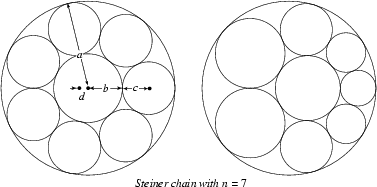|
|
|

Given two nonconcentric Circles with one interior to the other, if small Tangent Circles can be inscribed around the region between the two Circles such that the final Circle is Tangent to the first, the Circles form a Steiner chain.

The simplest way to construct a Steiner chain is to perform an Inversion on a symmetrical arrangement on ![]() circles
packed between a central circle of radius
circles
packed between a central circle of radius ![]() and an outer concentric circle of radius
and an outer concentric circle of radius ![]() (Wells 1991). In this arrangement,
(Wells 1991). In this arrangement,
| (1) |
| (2) |
To transform the symmetrical arrangement into a Steiner chain, take an Inversion Center which is a distance ![]() from the
center of the symmetrical figure. Then the radii
from the
center of the symmetrical figure. Then the radii ![]() and
and ![]() of the outer and center circles become
of the outer and center circles become
 |
(3) | ||
 |
(4) |
| (5) | |||
| (6) |
Steiner's Porism states that if a Steiner chain is formed from one starting circle, then a Steiner chain is also formed from any other starting circle.
See also Arbelos, Coxeter's Loxodromic Sequence of Tangent Circles, Hexlet, Pappus Chain, Steiner's Porism
References
Coxeter, H. S. M. ``Interlocking Rings of Spheres.'' Scripta Math. 18, 113-121, 1952.
Coxeter, H. S. M. Introduction to Geometry, 2nd ed. New York: Wiley, p. 87, 1969.
Coxeter, H. S. M. and Greitzer, S. L. Geometry Revisited. Washington, DC: Math. Assoc. Amer., pp. 124-126, 1967.
Forder, H. G. Geometry, 2nd ed. London: Hutchinson's University Library, p. 23, 1960.
Gardner, M. ``Mathematical Games: The Diverse Pleasures of Circles that Are Tangent to One Another.'' Sci. Amer. 240, 18-28, Jan. 1979.
Johnson, R. A. Modern Geometry: An Elementary Treatise on the Geometry of the Triangle and the Circle.
Boston, MA: Houghton Mifflin, pp. 113-115, 1929.
Ogilvy, C. S. Excursions in Geometry. New York: Dover, pp. 51-54, 1990.
![]() Weisstein, E. W. ``Plane Geometry.'' Mathematica notebook PlaneGeometry.m.
Weisstein, E. W. ``Plane Geometry.'' Mathematica notebook PlaneGeometry.m.
|
|
|
© 1996-9 Eric W. Weisstein